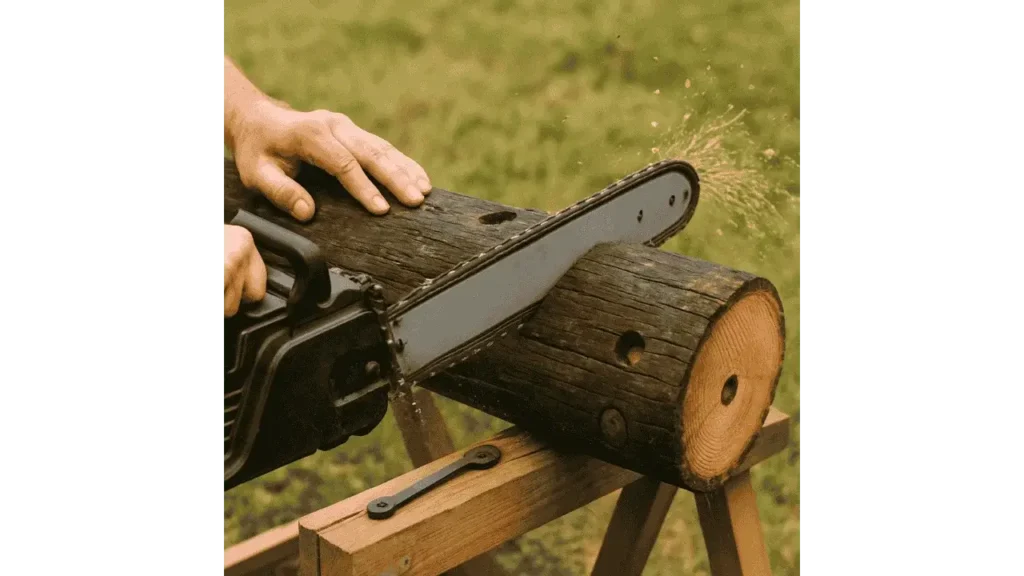Cutting a telephone pole with a chainsaw is possible, but it’s not like slicing through regular firewood. These poles are built to last decades and are typically made from dense hardwoods treated with creosote, a chemical preservative that protects them from rot and insects. If you’re prepared with the right equipment and take the proper precautions, you can cut a telephone pole safely and effectively, though the job comes with some unique hazards.

Material Characteristics of Telephone Poles
Telephone poles are usually crafted from hardwoods like cedar, pine, or Douglas fir. They’re incredibly dense and often 12 to 18 inches in diameter or more, making them much thicker than typical firewood. What makes them especially difficult to cut is the creosote treatment, a tar-like substance that not only gives off harmful vapors when heated, but also causes blades to dull much faster than usual. It’s a heavy-duty material that demands equally heavy-duty cutting tools.
Chainsaw Requirements
Power & Type
To take on a telephone pole, you’ll need a high-displacement gas-powered chainsaw, preferably 50cc or greater. Electric or low-powered chainsaws generally don’t have the torque or endurance to handle long, dense cuts. A heavy-duty bar paired with a robust engine is essential, especially for poles that exceed standard thickness.
Chain Type
The standard cross-cut chain found on most consumer chainsaws won’t perform well here. Instead, use a rip chain or semi-chisel chain. These are designed for cutting along the grain and handling dense woods more efficiently. Using the wrong type of chain not only slows you down but also increases the wear on your equipment.
“For dense, treated wood like utility poles, a rip chain is a must if you want to avoid stalling or chewing through chains too quickly,” says Mike Langston, a certified logger with over 25 years of field experience.
Cutting Challenges & Considerations
Blade Wear & Maintenance
Because creosote accelerates chain dulling, you’ll need to sharpen your chain more frequently or have multiple chains ready. Even a brand-new chain can lose its edge within a single pole if it’s heavily treated or embedded with grit.
Smoke and Fumes
Cutting through creosote-treated wood generates toxic fumes. These aren’t just unpleasant, they can be hazardous to your health. Always use a respirator mask rated for organic vapors, and make sure you’re working in a well-ventilated area or preferably outdoors.
“Working with treated lumber indoors without proper respiratory protection is a major health risk that too many DIYers overlook,” warns Sandra Choi, industrial hygienist and safety consultant.
Infeed and Pinch Risk
Given the wide diameter of telephone poles, your chainsaw bar may get pinched during the cut. To prevent this, use a proper two-step cutting technique: start with a shallow undercut, then switch to the top cut. This reduces the chance of your bar getting stuck mid-cut and allows for safer, controlled separation.
Recommended Cutting Process
Start by examining the pole carefully to identify any embedded nails, bolts, or staples, which are common in utility wood and can damage your chain. Once the cut line is clear, make a shallow undercut about one-third of the way in from the bottom side of the pole. This acts as a relief cut and prevents the wood from pinching your bar.
Switch to the top and complete the cut slowly, allowing gravity to help guide the fall. Instead of going for a single deep cut, make several controlled passes, which is easier on your machine and gives you more control. Always clear the area around the pole before finishing the cut, and step back once the section begins to shift.
Safety Equipment & PPE
You must wear chainsaw chaps, protective gloves, safety glasses, and hearing protection. Most importantly, use a respirator mask designed to handle creosote vapors, as inhaling the fumes from treated wood can be harmful. Always support the chainsaw firmly with both hands and avoid reaching or cutting from unstable positions. Good footing is critical.
Alternative Methods When Unsuitable
If the pole is exceptionally large, say 18 to 24 inches or more in diameter, you might be better off using a rip-saw mill head attachment or even hiring a professional arborist. Some poles are simply too heavy or complex to handle safely without professional equipment. If you lack the right saw, safety gear, or experience, outsourcing the job is often the smartest and safest option.
Key Takeaways
Yes, you can cut a telephone pole with a chainsaw, but it takes powerful tools, protective equipment, and the right technique. Creosote-treated wood dulls blades fast and produces harmful fumes, so safety gear is non-negotiable. If your saw isn’t up to the task or the pole is unusually large, call in a professional; the risks are simply too high to cut corners.
- How Many Watts Does a Circular Saw Use and Why Does It Matter? - December 1, 2025
- Can You Cut Acrylic With a Circular Saw Safely and Cleanly? - November 29, 2025
- Which Way Does a Circular Saw Blade Go on Your Saw? - November 28, 2025
